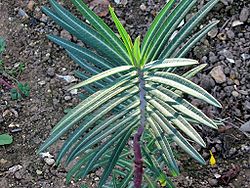Euphorbia lathyris
Read about Euphorbia lathyris in the Standard Cyclopedia of Horticulture
|
|---|
|
Euphorbia Lathyris, Linn. Caper Spurge. Mole Plant. Fig. 1447. Annual, 2-3 ft. tall: Lvs. long, lance- linear, those of the infl. ovate-acuminate: glands short-horned: caps, somewhat fleshy, ¼-½ in. diam. Eu., and naturalized in E. U. S. Rept. Mo. Bot. Gard. 11, pl. 11.—Cult. in old gardens. Caps, sometimes pickled, seeds used as a purgative. Said to drive away moles from its neighborhood (see Cornell Bull. 61:331); for a similar reason known as "gopher plant" in S. Calif.
|
| Euphorbia lathyris | ||||||||||||||||||||||
|---|---|---|---|---|---|---|---|---|---|---|---|---|---|---|---|---|---|---|---|---|---|---|
 Euphorbia lathyris | ||||||||||||||||||||||
| Plant Info | ||||||||||||||||||||||
|
| ||||||||||||||||||||||
| Scientific classification | ||||||||||||||||||||||
| ||||||||||||||||||||||
| Binomial name | ||||||||||||||||||||||
| Euphorbia lathyris L. | ||||||||||||||||||||||
|
| ||||||||||||||||||||||
| Synonyms | ||||||||||||||||||||||
| Euphorbia lathyrus (lapsus) |
Euphorbia lathyris (Caper Spurge or Paper Spurge) is a species of spurge native to southern Europe (France, Italy, Greece, and possibly southern England), northwest Africa, and eastward through southwest Asia to western China.[1][2][3]
Other names occasionally used include Gopher Spurge, Gopher Plant or Mole Plant.[1]
It is an erect biennial (occasionally annual) plant growing up to 1.5 m tall, with a glaucous blue-green stem. The leaves are arranged in decussate opposite pairs, and are lanceolate, 5-15 cm long and 1-2.5 cm broad, glaucous blue-green with a waxy texture and pale greenish-white midrib and veins. The flowers are green to yellow-green, 4 mm diameter, with no petals. The seeds are green ripening brown or grey, produced in globular clusters 13-17 mm diameter of three seeds compressed together.[3][4]
All parts of the plant, including the seeds and roots are poisonous. Handling may may cause skin irritation as the plant produces latex. While poisonous to humans and most livestock, goats sometimes eat it and are immune to the toxin. However, the toxin can be passed through the goat's milk.[5]
Away from its native range, it is widely naturalised in many regions, where it is often considered an invasive weed.[1][2][4] It grows in partial shade to full sun in USDA zones 5–9.
The Mole Plant is sold by some nurseries[6] as it is believed to repel moles. It is used in folk medicine as a poison, antiseptic, and a purgative. It is used as a folk remedy for cancer, corns, and warts.[7]
References
- ↑ 1.0 1.1 1.2 Germplasm Resources Information Network: Euphorbia lathyris
- ↑ 2.0 2.1 Flora Europaea: Euphorbia lathyris
- ↑ 3.0 3.1 Blamey, M. & Grey-Wilson, C. (1989). Flora of Britain and Northern Europe. ISBN 0-340-40170-2
- ↑ 4.0 4.1 Huxley, A, ed. (1992). New RHS Dictionary of Gardening. ISBN 0-333-47494-5
- ↑ Poisonous Plant Information: Caper Spurge
- ↑ Local Harvest: Mole Plant Seed
- ↑ Purdue University: Euphorbia lathyris
gn:Mba'ysyvo de:Kreuzblättrige Wolfsmilch es:Euphorbia lathyris fr:Épurge hu:Hasindító kutyatej nl:Kruisbladige wolfsmelk pl:Wilczomlecz groszkowy sq:Euphorbia lathyris
